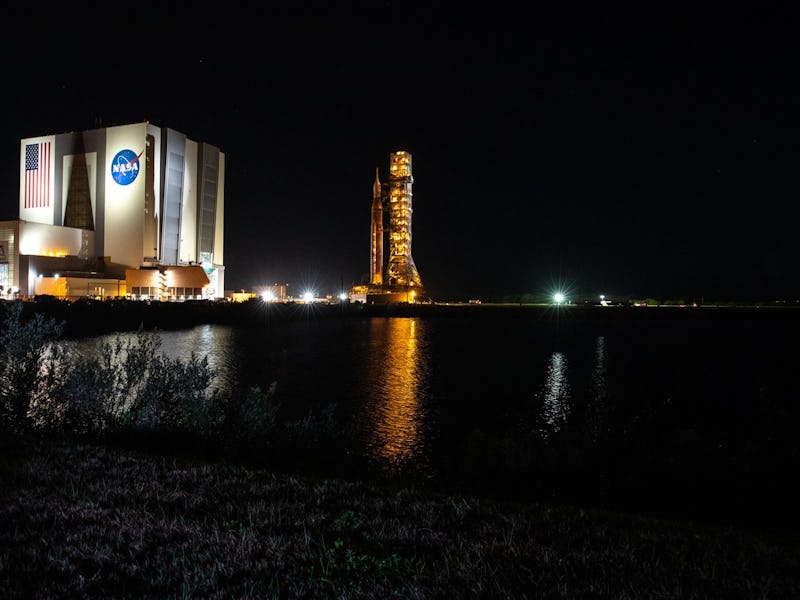Photo shows NASA's stunning Artemis I rocket ahead of launch
NASA is monitoring Subtropical Storm Nicole days ahead of its next target launch date for its Moon rocket Artemis I.

NASA’s Moon rocket Artemis I is back at the launchpad a week ahead of its next scheduled liftoff attempt. It will remain there for now. But that might change, as teams monitor threats from a strengthening Tropical Storm.
Updae: This story has been updated to reflect NASA’s new launch date of Wednesday, November 16, and with new information about Tropical Storm Nicole.
NASA photos from last Friday, November 4, show the 322-foot tall rocket at the beginning and end of its nine-hour journey across 4.2 miles inside NASA’s Kennedy Space Center (KSC) in Cape Canaveral, Florida. They depict the methodical work of the space agency’s Exploration Ground Systems team as they transported Artemis I. Team members are now preparing for the arrival of Tropical Storm Nicole, and the space agency will, for now, plan on leaving Artemis I at the launchpad.
The rocket is composed of a Space Launch System (SLS) and Orion capsule, and the stacked duo journeyed from the facility’s Vehicle Assembly Building (VAB) to Launchpad 39B beginning at 11:17 p.m. Eastern on Thursday, November 3. The heavy-lift SLS and Moon-bound Orion will hopefully fly on their first integrated test next week, on Wednesday, November 16. NASA announced this new launch date Tuesday evening, after Nicole grew more powerful.
If Artemis I does successfully launch next Wednesday, the mission will fly to the Moon and back as part of an uncrewed demonstration with implications for future lunar human exploration.
NASA’s Artemis I, made of the Space Launch System (SLS) rocket and the Orion spacecraft atop, rolls out of the Vehicle Assembly Building’s High Bay 3 late Thursday (November 3). Artemis I stands taller than the Statue of Liberty, and crews spent more than nine hours maneuvering the vehicle across 4.2 miles from the building to Launch Pad 39B at NASA’s Kennedy Space Center in Florida.
“During the flight, Orion will launch atop the most powerful rocket in the world and fly farther than any human-rated spacecraft has ever flown,” NASA Kennedy officials write in both image descriptions on the space agency’s Flickr account, “paving the way for human deep space exploration and demonstrating our commitment and capability to extend human presence to the Moon and beyond.”
If the scale of the pictures is any indication, NASA puts in a sizable effort any time it must change the rocket’s location. Developing weather reports of Tropical Storm Nicole might force ground teams to move Artemis I once again.
Artemis I arrives at Launch Pad 39B at NASA’s Kennedy Space Center in Florida on Nov. 4, 2022. According to NASA’s Artemis blog, the stacked Space Launch System rocket and the Orion capsule reached the launchpad at 8:30 a.m. Eastern.
The rocket reached the launchpad on Friday, November 4, at 8:30 a.m. Eastern, and it marked the first time Artemis I has been there since September 26, when Hurricane Ian prompted staff to evacuate and safeguard the rocket. Like Ian, Nicole triggered a Hurricane Condition, or HURCON, status at KSC.
“NASA is working with U.S. Space Force and the National Hurricane Center to monitor Subtropical Storm Nicole,” NASA officials wrote in an Artemis I blog post published Monday, November 7. The storm has since upgraded to a Tropical Storm.
On Tuesday, November 8, the Artemis blog published a statement that said, “NASA is continuing to monitor Tropical Storm Nicole and has decided to re-target a launch for the Artemis I mission for Wednesday, Nov. 16, pending safe conditions for employees to return to work, as well as inspections after the storm has passed. Adjusting the target launch date will allow the workforce to tend to the needs of their families and homes, and provide sufficient logistical time to get back into launch status following the storm.”
NASA states it will provide updates about how it will proceed with Apollo’s would-be successor.